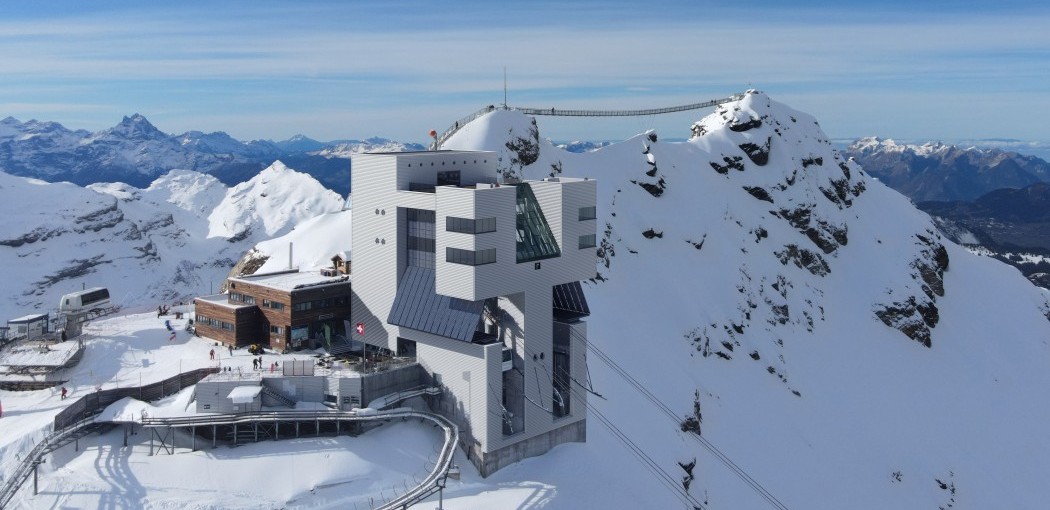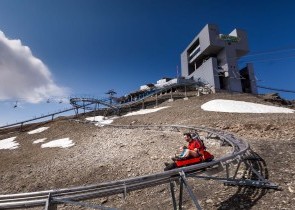New Restaurant Botta
Reconstruction of the new restaurant has begun
Following the terrible fire that destroyed the Glacier 3000 restaurant last September, the time has come to rebuild. A new project will be launched this summer, designed by the famous Swiss architect, Mario Botta. The building, which will also feature an alpine solar micro power plant, has been redesigned to enhance both the quality of the client experience and fire safety.
At the top of Glacier 3000, workers have been busy since April in difficult conditions to dismantle the metal structure that survived the fire and to clear the concrete slab-work. "This first phase is now almost complete, and the reconstruction work can begin in the next few days," enthuses the company CEO, Bernhard Tschannen. It is for this occasion that architect Mario Botta's plan was unveiled to the press today. While for planning permission reasons, the building's exterior appearance will be virtually identical, the interior space has been completely redesigned, with a 35m2 increase in surface area per floor and the addition of new panoramic windows in the corners. In close collaboration with the Etablissement cantonal d'assurance (ECA) in the canton of Vaud, fire safety has also been reviewed, with the installation of a brand-new fire extinguishing system using foggers and additional fire escapes on the south-west side.
A new panoramic terrace
From the summer of 2024, the restaurants will offer a total of 400 seats over two floors, in a warm atmosphere, with more spacious and luminous dimensions, and the total separation of the establishments. An innovative concept has been devised for the “Le 3” restaurant (formerly a Self-Service restaurant): ordering and payment will be done via a QR code, with the dishes then served at the table. For Bernhard Tschannen, queuing with a tray in ski boots will be a thing of the past: "We're maintaining the fast service clients expect from an establishment of this kind, but enhancing the quality of the client experience". Lastly, a 250m2 panoramic terrace will be built on the roof of the building, 25 metres above the ground, offering an uninterrupted view of the famous Peak Walk by Tissot suspension bridge, as well as the Matterhorn and 24 over 4,000-metre-high peaks.
A highly energy-efficient building
At a time when plans for solar power plants are burgeoning in the Alps, Glacier 3000's vision is to focus its energy efforts on improving what already exists, without increasing the footprint of the infrastructures. This is what was done in the restaurant reconstruction plan, where 600 solar panels capable of producing up to 110 KW were added on the south-west façade and side eaves – enough to cover most of the establishment’s energy consumption, and up to 6% of the company's total annual consumption. In addition, the heat released by the kitchens’ ventilation system and the running of the walk-in coolers will be recovered to produce hot water, while the building's perimeter insulation was specially designed to minimise heat-loss, a crucial point at an altitude of 3,000 metres.
Completing a unique architectural work
While Mario Botta ultimately withdrew from the initial project in 2000 following disagreements with the promoters at the time, the Ticino architect was keen to participate in the building’s rebirth: "I wanted to refresh the building’s appearance, by giving it an even more solid and resistant character, thus reinforcing the emblematic image of the Devil's Fork that has marked the identity of this place for the past twenty years". Following on from other tourist buildings in the mountains – like the “Fiore di pietra” on Monte Generoso in 2017 – the reconstruction of the Glacier 3000 restaurant is a distinctive project in the career of the Ticino artist, who celebrated his 80th birthday in April.




